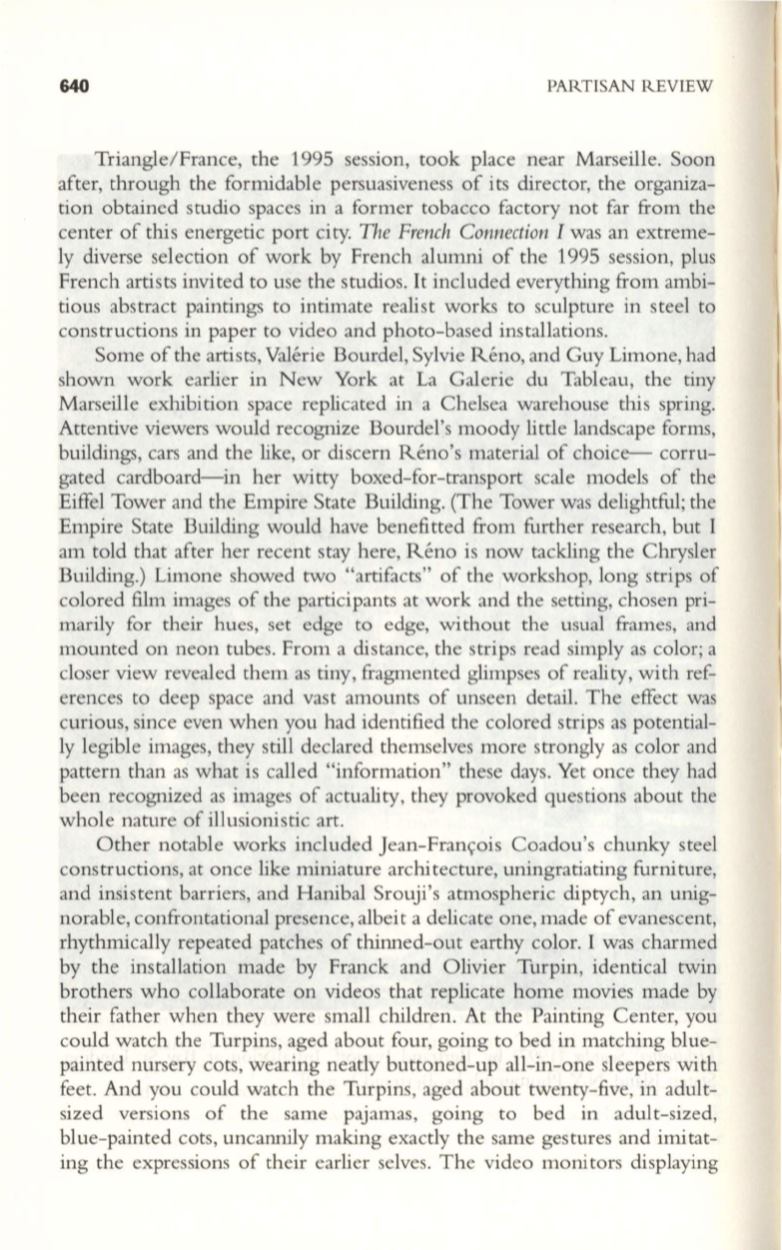
640
PARTISAN REVIEW
Triangle/France, the 1995 session, took place near Marseille. Soon
after, through the formidable persuasiveness of its director, the organiza–
tion obtained studio spaces in a former tobacco factory not far from the
center of this energetic port city.
The French Connection I
was an extreme–
ly diverse selection of work by French alumni of the 1995 session, plus
French artists invited to use the studios. It included everything from ambi–
tious abstract paintings to intimate realist works to sculpture in steel to
constructions in paper to video and photo-based installations.
Some of the artists, Valerie Bourdel, Sylvie Reno, and Guy Limone, had
shown work earlier
in
New York at La Galerie du Tableau, the tiny
Marseille exhibition space replicated in a Chelsea warehouse this spring.
Attentive viewers would recognize Bourdel's moody little landscape forms,
buildings, cars and the like, or discern Reno's material of choice- corru–
gated cardboard-in her witty boxed-for-transport scale models of the
Eifld Tower and the Empire State Building. (The Tower was delightful; the
Empire State Building would have benefitted from further research, but I
am told that after her recent stay here, Reno is now tackling the Chrysler
Building.) Limone showed two "artifacts" of the workshop, long strips of
colored film images of the participants at work and the setting, chosen pri–
marily for their hues, set edge to edge, without the usual frames, and
mounted on neon tubes. From a distance, the strips read simply as color; a
closer view revealed them as tiny, fragmented glimpses of reality, with ref–
erences to deep space and vast amounts of unseen detail. The effect was
curious, since even when you had identified the colored strips as potential–
ly legible images, they still declared themselves more strongly as color and
pattern than as what is called "information" these days. Yet once they had
been recognized as images of actuality, they provoked questions about the
whole nature of illusionistic art.
Other notable works included Jean-FranlYois Coadou's chunky steel
constructions, at once like miniature architecture, uningratiating furniture,
and insistent barriers, and Hanibal Srouji's atmospheric diptych, an unig–
norable, confrontational presence, albeit a delicate one, made of evanescent,
rhythmically repeated patches of thinned-out earthy color. I was charmed
by the installation made by Franck and Olivier Turpin, identical twin
brothers who collaborate on videos that replicate home movies made by
their father when they were small children. At the Painting Center, you
could watch the Turpins, aged about four, going to bed in matching blue–
painted nursery cots, wearing neatly buttoned-up all-in-one sleepers with
feet. And you could watch the Turpins, aged about twenty-five, in adult–
sized versions of the same pajamas, going to bed in adult-sized,
blue-painted cots, uncannily making exactly the same gestures and imitat–
ing the expressions of their earlier selves. The video monitors displaying


